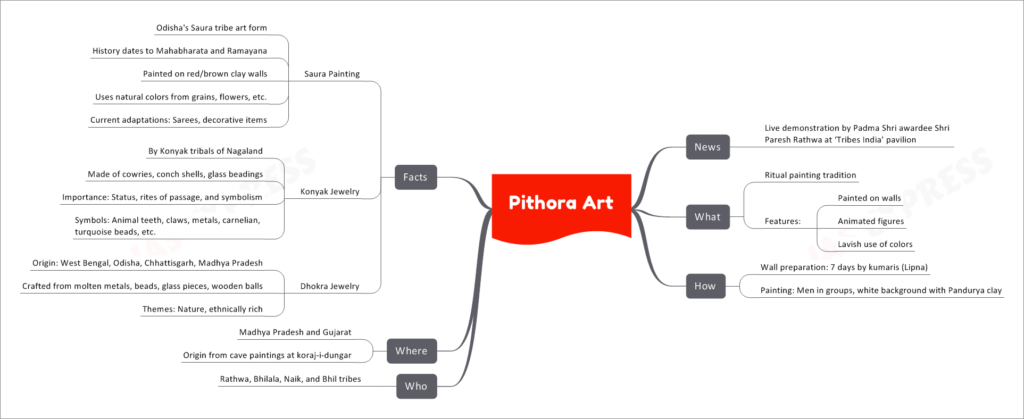Pithora Art

- Live Demonstration by Padma Shri Awardee Shri Paresh Rathwa at ‘Tribes India’ Pavilion
This topic of “Pithora Art” is important from the perspective of the UPSC IAS Examination, which falls under General Studies Portion.
What is Pithora Art?
Pithora Art is a ritualistic painting tradition practiced by various tribal communities in the states of Madhya Pradesh and Gujarat, India. It is characterized by its unique features:
- Painted on Walls: Pithora paintings are typically created on the walls of homes and community spaces.
- Animated Figures: These paintings feature animated and often mythical figures, reflecting tribal folklore and traditions.
- Lavish Use of Colors: Pithora art is known for its vibrant and lavish use of colors, creating visually striking compositions.
How is Pithora Art Created?
The creation of Pithora art involves several steps:
- Wall Preparation: The walls are meticulously prepared for painting, a process that takes up to 7 days and is carried out by kumaris or young girls known as Lipna.
- Painting: The actual painting is done by men in groups. A white background is created using Pandurya clay, which provides a base for the colorful artwork.
Who Practices Pithora Art?
Pithora Art is practiced by several tribal communities, including the Rathwa, Bhilala, Naik, and Bhil tribes in Madhya Pradesh and Gujarat.
Where Can Pithora Art Be Found?
This unique tribal art form is primarily found in the tribal regions of Madhya Pradesh and Gujarat.
Facts About Pithora Art
Pithora Art traces its origin to cave paintings at Koraj-i-Dungar, reflecting its ancient roots and cultural significance among tribal communities.
Other Indigenous Art Forms and Crafts
Saura Painting
- Origin: Saura Painting is an art form belonging to Odisha’s Saura tribe, with historical roots dating back to the Mahabharata and Ramayana eras.
- Medium: These paintings are created on red or brown clay walls.
- Natural Colors: Saura paintings make use of natural colors derived from grains, flowers, and other organic sources.
- Contemporary Adaptations: Today, Saura art is also adapted to items like sarees and decorative pieces.
Konyak Jewelry
- Crafted by: Konyak tribals of Nagaland, this jewelry is made from a variety of materials, including cowries, conch shells, glass beadings, and more.
- Importance: Konyak jewelry holds great significance in terms of status, rites of passage, and symbolism.
- Symbols: It often features symbols like animal teeth, claws, metals, carnelian, turquoise beads, and more, each carrying cultural and traditional meanings.
Dhokra Jewelry
- Origin: Dhokra jewelry hails from West Bengal, Odisha, Chhattisgarh, and Madhya Pradesh.
- Materials: Crafted from molten metals, beads, glass pieces, wooden balls, and other materials.
- Themes: Dhokra jewelry often reflects themes inspired by nature and the ethnically rich traditions of the regions where it is produced.
These indigenous art forms and crafts, including Pithora Art, Saura Painting, Konyak Jewelry, and Dhokra Jewelry, serve as vibrant expressions of India’s rich tribal heritage and cultural diversity. They not only preserve traditional knowledge but also provide a source of livelihood and cultural identity for tribal communities.

